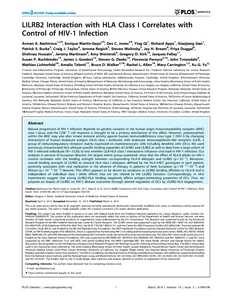Bashirova, AA;
Martin-Gayo, E;
Jones, DC;
Qi, Y;
Apps, R;
Gao, X;
Burke, PS;
Taylor, CJ;
Rogich, J;
Wolinsky, S;
et al.
Bashirova, AA; Martin-Gayo, E; Jones, DC; Qi, Y; Apps, R; Gao, X; Burke, PS; Taylor, CJ; Rogich, J; Wolinsky, S; Bream, JH; Duggal, P; Hussain, S; Martinson, J; Weintrob, A; Kirk, GD; Fellay, J; Buchbinder, SP; Goedert, JJ; Deeks, SG; Pereyra, F; Trowsdale, J; Lichterfeld, M; Telenti, A; Walker, BD; Allen, RL; Carrington, M; Yu, XG
(2014)
LILRB2 Interaction with HLA Class I Correlates with Control of HIV-1 Infection.
PLoS Genet, 10 (3).
e1004196 -e1004196(10).
ISSN 1553-7390
https://doi.org/10.1371/journal.pgen.1004196
SGUL Authors: Allen, Rachel Louise
![[img]](https://openaccess.sgul.ac.uk/105317/1.hassmallThumbnailVersion/pgen.1004196.pdf)  Preview |
|
["document_typename_application/pdf; charset=binary" not defined]
Published Version
Download (337kB)
| Preview
|
Abstract
Natural progression of HIV-1 infection depends on genetic variation in the human major histocompatibility complex (MHC) class I locus, and the CD8+ T cell response is thought to be a primary mechanism of this effect. However, polymorphism within the MHC may also alter innate immune activity against human immunodeficiency virus type 1 (HIV-1) by changing interactions of human leukocyte antigen (HLA) class I molecules with leukocyte immunoglobulin-like receptors (LILR), a group of immunoregulatory receptors mainly expressed on myelomonocytic cells including dendritic cells (DCs). We used previously characterized HLA allotype-specific binding capacities of LILRB1 and LILRB2 as well as data from a large cohort of HIV-1-infected individuals (N = 5126) to test whether LILR-HLA class I interactions influence viral load in HIV-1 infection. Our analyses in persons of European descent, the largest ethnic group examined, show that the effect of HLA-B alleles on HIV-1 control correlates with the binding strength between corresponding HLA-B allotypes and LILRB2 (p = 10-2). Moreover, overall binding strength of LILRB2 to classical HLA class I allotypes, defined by the HLA-A/B/C genotypes in each patient, positively associates with viral replication in the absence of therapy in patients of both European (p = 10-11-10-9) and African (p = 10-5-10-3) descent. This effect appears to be driven by variations in LILRB2 binding affinities to HLA-B and is independent of individual class I allelic effects that are not related to the LILRB2 function. Correspondingly, in vitro experiments suggest that strong LILRB2-HLA binding negatively affects antigen-presenting properties of DCs. Thus, we propose an impact of LILRB2 on HIV-1 disease outcomes through altered regulation of DCs by LILRB2-HLA engagement.
Statistics
Item downloaded times since 31 Mar 2014.
Actions (login required)
 |
Edit Item |




